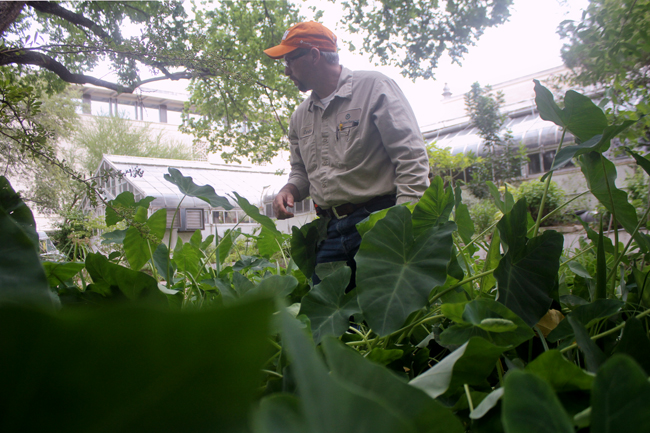Christine Ayala
May 3, 2013
Chicken nuggets and fries are a common lunch on campus, including for the hundreds of turtles swimming in the Turtle Pond’s murky water.
Directly north of the Main Building, the pond crawls with more than 200 turtles of at least four different species. Most are red-eared sliders native to the area.
Curtis Drosche, a Facilities Services mechanical maintenance technician, oversees the pond’s water levels and keeps the habitat clear of trash and debris.
Drosche said the pond essentially sustains itself. No office on campus takes care of the individual turtles or provides food, although people tend to feed the turtles their lunch leftovers. Drosche said two of the inhabitants are alligator turtles that have been known to catch unaware birds. He said the other turtles have similar appetites to the students on campus.
“They’ll eat anything,” Drosche said. “People feed them a lot of scraps when they pass by after lunch. They don’t like lettuce though, they’re spoiled, they like what the kids eat.”
Drosche said throughout the 11 years he has taken care of the pond, a lack of communication between Facilities Services and the College of Natural Sciences regarding responsibility for the pond has blocked improvements to the area.
“Nobody really knows who is in charge of it, and nobody seems to want to take responsibility, so we just do what we can to keep the water flowing and keep up the area,” Drosche said. “We’ve wanted to replace a few parts of the piping to make the system run better, but we’re not turtle experts, so we don’t know what might harm them.”
Drosche said he has asked about draining the pond to do a thorough inspection of the water system for years, but he has not been able to connect with biology experts to determine the best time of year to remove the turtles or where they could be housed during the process.
Several fish live in the pond including bass, catfish and goldfish, according to Drosche. When the pond was introduced in the 1930s, it included just two species of turtles, but now the pond is swimming with several pet turtles and fish that have been dumped there by folks on campus over the years.
Integrative biology professor David Hillis said he has volunteered to manage the turtle population since the late 1990s, although he is not responsible for the pond.
“We try to keep only native species of turtles in the pond so that they are appropriate for our weather conditions,” Hillis said.
Hillis said the turtles breed and lay eggs around the pond and courtship behavior can be observed often.
“I get lots of calls from people who are concerned that the small turtles are ‘picking on’ the larger ones,” Hillis said. “It looks like the little turtles are trying to slap the big ones in the face. In fact, the small turtles are males, and the larger ones are females, and the males are displaying their feet to the females, and tickling the females with the male’s long fingernails, which is part of their normal mating behavior.”
The turtles commonly lay their eggs around the pond in grassy areas under trees and bushes — even across the street at adjacent buildings.
Integrative biology professor David Crews said he specifically studies the reproduction of the red-eared slider. Crews said the temperature of the eggs during incubation determines the turtle’s sex.
Drosche said his team maintains the water levels with a recirculation system that takes water from the lower pond up to a bog area with foliage. From there, the water flows back down to the turtles. The pond water uses this recycled water unless levels get too low and water must be added.
“We clean out each of the little areas with waterfalls where debris will build with leaves, sticks and trash, and check on it every other day to see how things are running,” Drosche said. “We know other people try too. We come some days, and it has been cleared. There is just no communication between them and us. It would be nice if there was a main group that wanted to take charge.”

